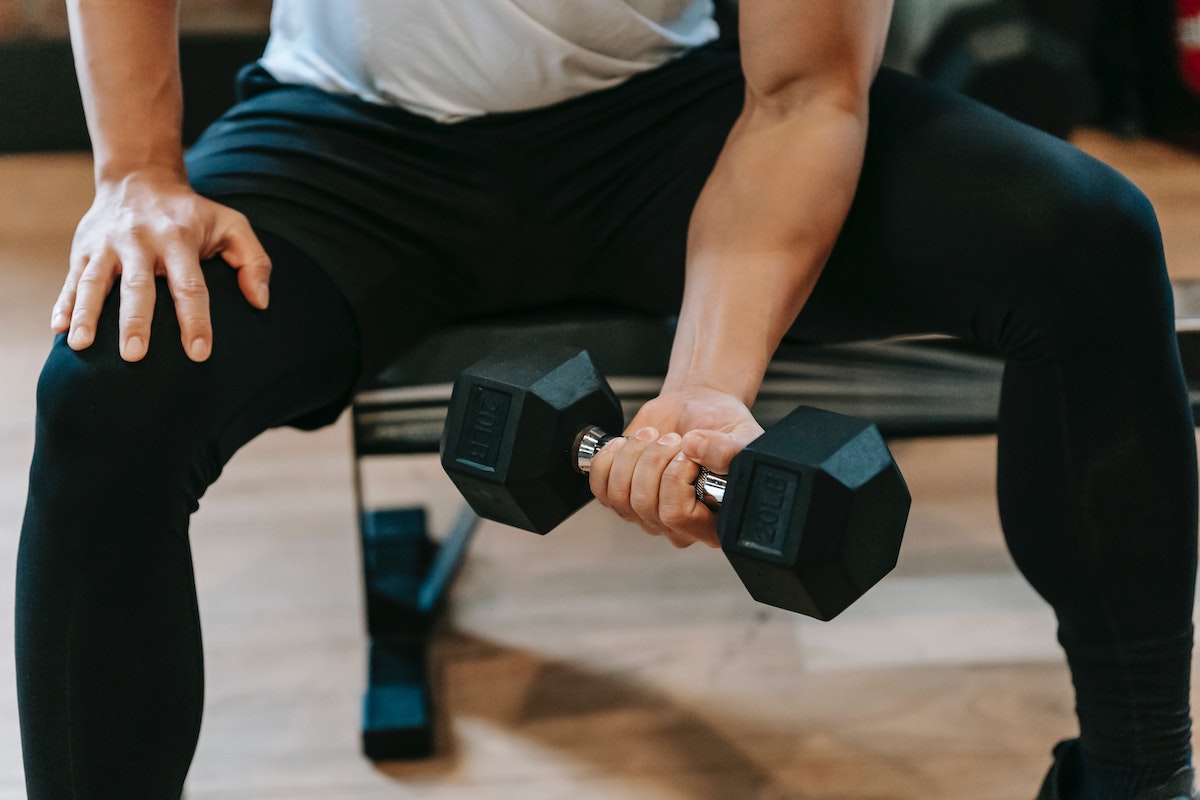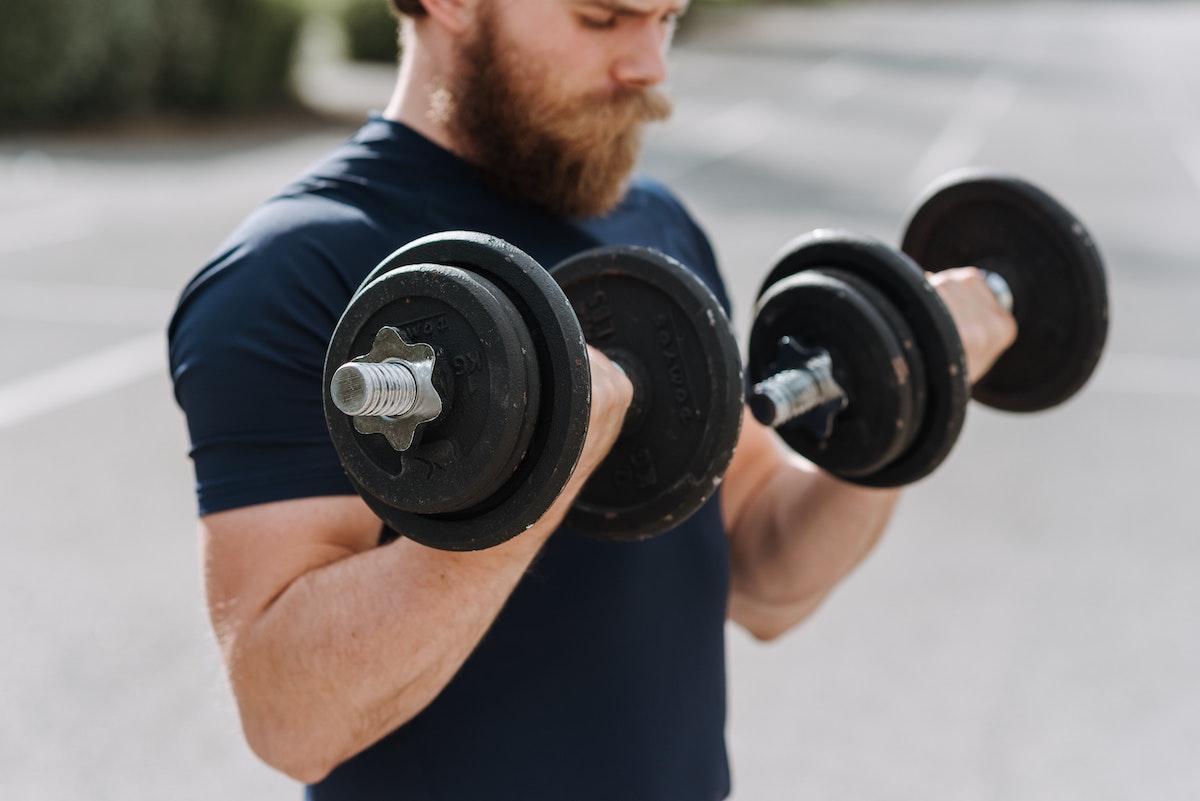Bicep curls help strengthen and tone the arms, making everyday activities such as lifting and carrying easier. Therefore, they are a fundamental exercise in any strength-building program.
As the name implies, bicep curls target the biceps, and by doing so, they help to improve general arm strength. When done properly, they are a safe and effective exercise that can be combined with other upper body-building movements.
Bicep curls are a useful addition to any training regime, so whether you are a beginner or a gym pro, adding bicep curls to your routine can help you achieve your fitness goals. Keep reading to learn how to do bicep curls properly and variations you can try.
What muscles do bicep curls work?

The name of the exercise itself gives a clue as to what muscle group bicep curls primarily work. However, curls also activate the muscles in the forearms, and slight adjustments in the types of curls can cause activation in the front delts, core, and other muscles.
However, these curls are designed to work all parts of the bicep brachi, including both the long head and the short head. The arm flexors, such as the anterior deltoid muscle, are also activated.
What equipment do you need for bicep curls?

A bicep curl is best done using dumbbells or a barbell. Beginners can do empty barbell curls, which are bicep curls without any weights on the bars. A short bar can range from 15 to 45 pounds. Even resistance bands can be used for this particular exercise.
If you are a beginner, it is best to slowly increase the weight you add to the equipment as your arm strength increases. This will help prevent injuries such as muscle pulls from occurring.
Although bicep curls are easy to learn, they are best done in a gym environment with a trainer. When mastered and if you have the equipment, they can eventually be done at home.
How to do a bicep curl

- Stand with feet shoulder-width apart and hold a dumbbell in each hand. Make sure the dumbbells provide a challenge but will not put you at risk of injury.
- Keep your back and neck straight and your gaze straight ahead. Lock your elbows into your sides and brace your core.
- Bend your elbows and slowly curl the weights upwards toward your shoulders. Pause briefly before slowly lowering the dumbbells in a controlled manner to the starting position by your sides.
- Perform 3 to 4 sets of 10 to 15 reps.
Bicep curl variations

- Resistance band curls: Stand up straight with your feet shoulder-width apart. Place your feet on the center of the band to hold it into position. Grip the resistance band handles with your palms facing upwards. Pull the handles up to shoulder height in unison, and then slowly lower them until your arms straighten.
- Barbell curls: Stand with your feet shoulder-width apart. Evenly grip the barbell at waist level with both hands, curl it up towards your chest, and then lower it until your arms straighten. Remember to keep your elbows pressed against your side throughout the movement.
- Hammer curls: Stand up straight with feet shoulder-width apart and hold two dumbbells with your palms facing each other. Make sure your elbows are slightly in front of your hips. Raise the dumbbells until your elbows pass 90 degrees, briefly hold the position, and slowly lower the weights until your arms straighten.
- Concentration curls: Sit on a gym bench with your knees bent and feet planted on the floor. Rest your right elbow on the inside of your right knee, and hold a dumbbell in the same hand with your palm facing up. Using your leg to stabilize your arm, curl the dumbbell to your chest and then release it back down to the starting position. Switch sides after completing a predetermined number of reps.
- Preacher curls: You will need a preacher bench to complete this particular variation of a bicep curl. Sit on the bench with your feet on the floor and your knees bent at 90 degrees. Keep your chin tucked closely to your chest, and allow your triceps to be supported by the pad. Grip an EZ bar with a wide underhand grip, pull the bar to shoulder height, hold, and return to the starting position.
Frequently asked questions

How do you build biceps for beginners?
For beginners, it is all about building momentum. To do so, you need to start slowly with lighter weights and focus on proper technique to prevent injury. Gradually increase resistance as you gain strength and master bicep curls and other specific exercises.
Aim to train your biceps two to three times per week. You also shouldn’t forget rest days, as they are important for muscle fiber building and recovery. Adding some extra protein to your diet can support muscle growth.
How to do bicep curls with EZ bar?
Stand up straight and hold the EZ bar using an underhand grip, hands on the metal meshes. Keep your elbows locked into your sides. Bend your elbows and flex your biceps to bring the EZ bar upwards towards your chest. While doing so, keep your back straight and do not slouch or swing your body. Slowly lower the bar back down to the starting position before performing another rep.
The EZ bar allows for a wider grip version of a bicep curl; this works the forearms and shoulders a little harder than some other curl variations.
What is one common mistake when doing bicep curls?
A common mistake is swinging the weights or using momentum to lift them, which comes from the hips instead of the arms. This reduces the effectiveness of the exercise and increases the risk of injury.
Remember to keep your back straight, lock your elbows into your sides, brace your core, and let your arms flex so that the biceps take the majority of the force of each curl. If you are worried you will still use momentum, try doing curls while seated.
Is there a wrong way to do bicep curls?
Yes, there is a wrong way to perform bicep curls, and this involves issues with technique, such as arching your back, swinging your hips, or flaring your elbows. All lead to muscle imbalances and strain on the joints. Always prioritize proper technique for optimal results; this will help reduce injury risks to muscles and joints.




